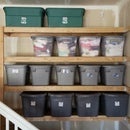Introduction: Closet Shelf
This instructable is about how to put shelving into a closet.
Before adding shelves here, everything was stacked on the ground which was a terrible waste of space and difficult to keep organized. I've intended on doing this project for some time now, and this weekend the stars aligned, so here you go.
Step 1: Tools You'll Need
• Measuring Tape
• Stud Finder
• Pencil / Eraser
• Nail Setter
• Triangle
• Square
• Level (large and small)
• Miter Saw
• Finish Nailer (2 - 2.5 inch 18 gauge)
• Air Compressor
• Materials
1. Shelf Brackets. The brackets I used are supposed to hold up to 100 lbs, although I'd be amazed if they really could. There are much stronger brackets out there but would impose on the space of the shelf below so I stuck with these.
2. Baseboard Molding. I chose a simple square shape to keep things simple. You can choose a decorative molding but it makes things more complicated when mounting the shelf brackets.
3. Melamine Board. I prefer to use the laminated boards since they're easy to clean off and you don't have to paint them. They cost about $4 more per board, but if you consider the cost of paint + supplies + time + energy = NOT WORTH IT.
4. Wood Glue / Dowels
Step 2: Total Cost
• Laminated Melamine Board
4 of 11.75"x97" @ $13.57 each
4 of 11.25"x97" @ $12.98 each
2 of 15.25"x97" @ $16.72 each
• Shelf Bracket
24 @ $1.88 each
• Baseboard Molding
8 @ $6.23
• Finish Nails
$12.98
• Wood Dowels
Pack of 26 @ $3.99
Total + Tax = $268.20
Naturally I could have done this for less money, but I wanted it to look nice with less work. If you're looking for cheap then plywood and 2x4's would be the better way to go.
Step 3: Sooo Shelfless...
This is the space I had to work with. When I framed in this doorway I didn't really think about how big my side shelves would be. I just measured all my doors at a wide 36 inches. This left me with only 13" on one side and 10" on the other. Not much to work with but it was deep enough to add a 15" shelf against the back wall.
Step 4: Measure Spaces Between Shelfs
Start on the center (back) wall and measure out your spacing. My shelves are 15" apart so I marked every 15" from the floor. Only do this once and for only one wall. The reason is most flooring isn't very level and if you measure from the floor each time you'll find your markings won't always line up.
Best thing to do is mark your spacing and use a level as a straight edge. Carry those lines to the corners and use the square to transfer the line to the next wall.
Depending on how meticulous you are, your lines should be pretty straight and level all the way around. I didn't spend too much time with it but found my lines were off by about 1/8 of an inch from end to end, which is good enough for me.
When all is finished you should have a bunch of lines on your walls as shown in the pictures above.
Step 5: Find All Your Studs
There are 2 methods of doing this:
1. I have a little magnetic "stud finder" I bought on Amazon for $7 and it works just as well or better than any stud finder I've ever used. It actually finds the screws that are driven into the stud (which may or may not be well centered). Once I found the stud on the upper part of the wall, I did similar for the same stud on the lower part of the wall and used the level as a straight edge to make tic marks above each line I drew.
2. Once you've found the top and bottom of the stud use a finish nail to tap holes below the horizontal line. These holes will be covered by the molding so don't worry about them. But this way you know for sure exactly where the stud is.
Of these 2 methods the first is much faster and proved to be fairly accurate on every stud except one, which happened to be the first stud I tested it on. For this stud the bottom screw was right on the edge so there's a chance I would have missed it, leading me to check all the studs. But, like I said, all the other ones were pretty close to center.
Step 6: Cut and Nail the Moldings
Since I've already marked level lines and located all the studs the rest will go by pretty fast. Simply:
1. Measure out your cut.
2. Line it up with the level line already marked on the wall.
3. Nail it where you've marked all the studs.
You can cut more than one molding at a time, but keep in mind that the adjacent walls will be shortened by the thickness of your molding, unless if you're crazy enough to miter your corners at 45 deg. then never mind.
TIPS & Tricks:
For the molding that will be in the corner, shave off the corner at a 45 deg (as shown in the picture). Doing this keeps a tight fit without forcing the drywall to crack at the seams. Those sharp cuts may not jive with the little rounded corners of the wall.
Also, keep in mind where the molding meets the door frame, you'll want to shave off another 45 deg cut just so there's a smooth transition from one to the next.
Step 7: Mount the Bracket Supports
As you can see in the picture, the bracket will not sit flush with the wall. Therefore you'll need to mount a support for it in order to attach it to the wall. Just hold up a bracket and measure out how long this needs to be. It doesn't need to be exact. Adding an extra inch or 2 adds a decorative touch. Remember to shave off another 45 deg edge on the bottom side of this as well. This will soften the edge and make it look much nicer.
I HIGHLY recommend that you only position these directly over the studs. You can place them over the drywall that's not backed by a stud but you'll have to use special screws to secure them and they won't be able to support much weight. Whereas having the support of a stud will provide a million times more strength!! They might look off center or asymmetrical but who the hell cares??... It's a closet!
Step 8: Setting Nails
If you've done everything right, most of your nails will be covered by the brackets. But for those that won't be covered, they need to be set about 1/16 of an inch below the surface of the molding. Do this using a nail setter and tap them in with a hammer.
Step 9: Cut the Side Shelves to Fit
It's likely that the corners of any room aren't exactly square. This means that when cutting the laminated melamine board you'll have to taper the front & back edges. Measure the distances where these edges will lay and this will give you an idea on how to angle these edges.
A trick for getting a good cut for this is to cut the length at the longest measurement then try to fit the board in position. This way you'll get a feel for which corners need to be shaved down.
Step 10: The Back Sehlf
The best way to do this one is to position it on top of the side shelves, even out the back edge against the wall as best as possible and then mark the cut lines from underneath.
When I did this I got perfect cuts every time.
Step 11: Supporting the Joints
Even if everything else was done perfectly, the boards may not line up on their edges as shown in the pictures above. To correct this and also add additional support, join the two edges with a few dowels. This will smooth out the levels of the shelf and add rigidity to them at the same time.
For doweling, there are some very nice (and expensive) tools out there that do a great job, but I used this Doweling Jig and Accessory Set I picked up from Harbor Freight for about $16. It's not the greatest tool but it worked just fine for this job.
Step 12: Optional
If you want to go the extra mile and add glue to this joint, tape the underside and drip some down from the top of the seam. The tape will prevent any glue from seeping through and creating a mess of things.
Step 13: Anchor in the Brackets
Finally secure in all of the shelf brackets with 1/4 inch Truss-head screws.
And you are done. Enjoy! :)

Participated in the
On a Budget Contest

Participated in the
Wood Contest













